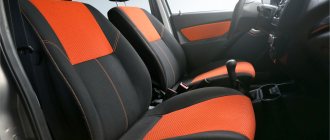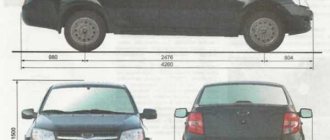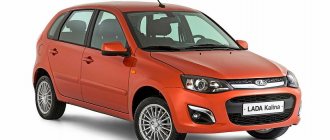With the abolition of Kalina, four different bodies appeared in the Lada Granta family. Moreover, the hatchback and station wagon have become even more accessible due to the emergence of new trim levels. Each option has its own buyer.
LADA > Granta
After restyling, there were four Grants: a sedan, a liftback, a hatchback and a station wagon.
VAZ has finally put things in order in the configurations, and now 14 versions are offered for each of the cars. They are the same for all body types. So, having chosen the optimal set of options, you won’t have to be upset that the Grant you need is not sold with it. Full parity. The most affordable is a sedan. It costs from 419,900 to 608,800 rubles. The liftback and hatchback are 17 thousand rubles more expensive, the surcharge for a station wagon is 27 thousand. Considering the class of the car, the money is not that small. For example, for 25 thousand you can get a robotic gearbox instead of a mechanical one or take the next level of equipment. Therefore, when economy comes first, the sedan is in favor.
If the configurations and power units are identical, all that remains is to choose a car only based on the parameters of the luggage compartment. Let's turn to dry numbers. The most spacious will be the sedan, for which AVTOVAZ claims a volume of 500 liters, which increases to 815 liters with the rear seats folded down. In second place is the liftback: 435/750 hp. The station wagon turned out to be not quite a cargo vehicle. Due to the “cut off” stern, it loses in volume to the liftback, having only 360/675 liters. The last one is a hatchback. With a five-seat cabin configuration, only 240 liters remain for luggage. Folding the seat increases the volume to 555 liters. It seems like a point in favor of the sedan again, but only if you are sure that you will not need to transport large items.
Even a casual glance at any of the five-door Grants is enough to realize their advantages. The large opening of the fifth door, which rises along with the glass, allows you to load large items that cannot be crammed into a sedan. And the first place here should be given to the liftback. It has the most impressive opening and maximum trunk volume. So the sedan is the leader in displacement only on paper, but in real life there is no equal to the liftback.
Note that the VDA technique involves measuring volume along the window sill line. Neither the manufacturer nor we measure to the ceiling (no measuring cubes are enough). But we can assume that the leaders in terms of full load will be the liftback and station wagon. The sedan has an obvious disadvantage due to its limited horizontal trunk lid, and we write off the hatchback, again due to the short rear overhang.
Let's not forget about design, although, of course, it is secondary for many. But, in my opinion, the liftback is the most harmonious and beautiful Grant. In addition, after restyling, it was refined with a bumper cover in body color, adding originality.
As a result, the liftback is in the lead. A more expensive station wagon can justify its price with anything but trunk space. But more than that, he is no different from his brothers! It’s awkward to even discuss a hatchback at the same price. Well, unless you liked his appearance. And the savings on a sedan will come back to haunt you the first time you need to transport something bulky.
Station wagon Lada Granta FL: detailed review (+photos)
Detailed review of the serial Lada Granta FL station wagon in the Classic configuration.
The new family of LADA Granta FL cars, sales of which started on September 1, 2022, includes four bodies - a sedan, a liftback, a station wagon and a hatchback, reports the Avtospravochnaya.com portal. Previously, we published a review of the LADA Granta FL sedan, liftback and hatchback. Now it's time to talk about the station wagon.
Photo of Lada Granta station wagon 2022
After restyling the model, Lada Granta began to look very much like Lada Vesta. But the rear body has remained virtually unchanged. In fact, the car received a completely finished exterior. See photos of the updated model below.
Options and prices
| Equipment: | Motor | Fuel consumption | checkpoint | Maximum speed km/h | Acceleration to 100 km/h | type of drive | Price |
| Standard | gasoline 1.6 l. (87 hp) | 9.1/5.3/6.8 | M.T. | 172 | 11.9 | Front | 446,900 rubles |
| Classic | gasoline 1.6 l. (87 hp) | 9.1/5.3/6.8 | M.T. | 172 | 11.9 | Front | 480,500 rubles |
| Classic Optima | gasoline 1.6 l. (87 hp) | 9.1/5.3/6.8 | M.T. | 172 | 11.9 | Front | 506,500 rubles |
| gasoline 1.6 l. (106 hp) | 8.7/5.2/6.5 | AMT | 184 | 12.2 | Front | 546,500 rubles | |
| Comfort | gasoline 1.6 l. (87 hp) | 9.1/5.3/6.8 | M.T. | 172 | 11.9 | Front | 526,500 rubles |
| gasoline 1.6 l. (106 hp) | 8.7/5.2/6.5 | M.T. | 184 | 10.7 | Front | 541,500 rubles | |
| gasoline 1.6 l. (106 hp) | 8.7/5.2/6.5 | AMT | 184 | 12.2 | Front | 566,500 rubles | |
| gasoline 1.6 l. (98 hp) | 9.9/6.1/7.2 | AT | 176 | 13.1 | Front | 606,500 rubles | |
| Lux | gasoline 1.6 l. (87 hp) | 9.1/5.3/6.8 | M.T. | 172 | 11.9 | Front | 563,800 rubles |
| gasoline 1.6 l. (106 hp) | 8.7/5.2/6.5 | M.T. | 184 | 10.7 | Front | 578,800 rubles | |
| gasoline 1.6 l. (106 hp) | 8.7/5.2/6.5 | AMT | 184 | 12.2 | Front | 603,800 rubles | |
| gasoline 1.6 l. (87 hp) | 9.9/6.1/7.2 | AT | 176 | 13.1 | Front | 633,800 rubles | |
| Luxury Prestige | gasoline 1.6 l. (106 hp) | 8.7/5.2/6.5 | M.T. | 184 | 10.7 | Front | 597,800 rubles |
| gasoline 1.6 l. (106 hp) | 8.7/5.2/6.5 | AMT (robot) | 184 | 12.2 | Front | 622,800 rubles |
Equipment and options
Equipment – Standard
Price: 446,900 rubles Engine and gearbox: 1.6 87 hp, MT
The basic standard modification is modestly equipped with 14-inch wheels, a 12-volt socket, airbags, child seat mounts and a cabin air filter.
Equipment – Classic
Price: 480,500 rubles Engine and gearbox: 1.6 87 hp, MT Version Lada Granta Station Wagon Classic, in addition to the standard, is equipped with an on-board computer, electric power steering, electric windows for front doors, gear shift prompt, hubcaps, etc. (see details)
Version - Classic Optima
Price: from 506,500 rubles Engine and gearbox: 1.6 87 hp and 1.6 106 hp, MT and AMT Lada Granta Universal 2018 in the Classic Optima configuration, quite well equipped, has: air conditioning, heated exterior mirrors, rear seat folds out into ratio 60/40.
Equipment – Comfort
Price: from 526,500 rubles Engine and gearbox: 1.6 87 hp and 1.6 106 hp, 1.6 98 hp AT, MT and AMT Granta Universal in the comfort modification is equipped, in addition to other modifications, with an audio system with Bluetooth, USB, Hands free , FM and SD card, side door moldings, side mirrors with turn signal indicator and door handles in body color.
Lada Granta Station Wagon Luxe
Price: from 563,800 rubles Engine and gearbox: 1.6 87 hp and 1.6 106 hp, 1.6 98 hp AT, MT and AMT Luxury equipment is equipped with fog lights, climate control, driver's seat adjustment, heated windshield, light tinting of windows, etc. (full list when choosing engines (buttons below))
Lada Granta Station Wagon Luxe Prestige
Price: from 597,800 rubles Engine and gearbox: 1.6 87 hp and 1.6 106 hp, 1.6 98 hp AT, MT and AMT Top-end Luxury Prestige equipment is equipped with heated front seats, parking sensors (parking sensors), rain sensor and lights, etc. (full list when choosing motors (buttons below))
Specifications
| Modifications | 1.6 87 hp (MT) | 1.6 106 hp (manual transmission) | 1.6 106 hp (AMT Robot) |
| Production year: | 2018 | ||
| Brand country | Russia | ||
| Country of assembly | Russia | ||
| Number of seats | 5 | ||
| type of drive | front | front | front |
| Length mm | 4268 | 4268 | 4268 |
| Width mm | 1700 | 1700 | 1700 |
| Height mm | 1500 | 1500 | 1500 |
| Wheelbase mm | 2476 | 2476 | 2476 |
| Ground clearance, mm | 190 | 190 | 190 |
| Trunk volume, liters | 520/815 | 520/815 | 520/815 |
| Fuel consumption (l): | |||
| City | 9,1 | 8,7 | 8,7 |
| Route | 5,3 | 5,2 | 5,2 |
| Average | 6,8 | 6,5 | 6,5 |
| Acceleration to 100 km/h, seconds | 11,9 | 10,7 | 12,2 |
| Maximum speed, km/h | 172 | 184 | 184 |
| Vehicle weight, kg | 1075 | 1160 | 1160 |
Restyled Lada Granta: full review of new products and jambs
This fall, AvtoVAZ brought a lot of fruit to its consumers - these are new versions of the XRAY hatchback, as well as the Lada Vesta, a slightly modernized Lada 4x4, but perhaps the most important event was the appearance of the updated Lada Granta family. And we have already tested the sedan and hatchback.
From now on, Lada Kalina is no more. Now both the sedan and the liftback, as well as the hatchback and station wagon, along with the off-road version of the Cross, will be sold with the Granta nameplate. At the instigation of maestro Steve Mattin, Granta received a new X-face in the spirit of the older models - Vesta and Xray: headlights on a dark glossy backing, a black radiator grille with large slats and chrome inserts on the bumper. All this forced the creators to change not only the shape of the hood, but also the front fenders.
Due to the new “cladding,” the length of the sedan increased by 8 mm, the liftback by 4 mm, the hatchback by 33 mm and the station wagon by 34 mm. Colored bumpers are already included in the basic version
A small rearrangement also took place in the area of the A-pillars: the windshield washer nozzles moved from the hood to a plastic “jabot” near the windshield, and duplicate turn indicators in top versions were implanted into the side mirrors. The logo with a rook on the front has also increased, and the inscription “LADA” appears on the back instead of the emblem. By the way, on sedans, at the very edge of the trunk lid (above the “LADA” inscription) a tiny protrusion a la spoiler appeared. According to the creators, the new appearance has improved aerodynamics by 1.5%.
Headlights for the new Granta were collected all over the world. Specialists from Neolite Zkw Lightings Pvt Ltd took part in the development. (India) and Genter Service GmbH (Germany), and they are produced in the Uzbek Namangan at the UzChasis enterprise
But that's not all. In the sedan, the place for the license plate has moved from the bumper to the trunk lid, and both of these parts have received more prominent shapes so that the rear does not look heavy as before. The liftback now has a dark insert on the bumper, which houses parking sensors and is not an eyesore. True, the hatchback and station wagon have unpainted parking sensors located higher, like the sedan, which is why three black dots are already visible on the bumper.
The turn indicators in top versions are located in the side mirrors. The windshield washer nozzles are covered by the hood cover, which now has a slight rise near the windshield - this allows the incoming air flow to better clean the glass
The final touches to the portrait of the restyled model were a new wheel design and two new paint colors. One of them is “carnelian”. In the language of VAZ colorists, this is a rich red color; the test hatchback was painted in it. The second new color is “techno”, we haven’t seen it yet. It has not yet been presented on the official website, but, as we found out, a gray metallic color will be hidden under this name. The name is clearly more euphonious than “blue planet”, which is also present in the palette.
Felt fender liners are used in all wheel arches - this allows you to level out noise from sandblasting and drumming pebbles. The inside of the hood has an additional seal that protects the engine compartment from flying dirt.
In the cabin, the instrument cluster with a new on-board computer, which has a contrast screen, like on Vesta, is striking. There are no fundamental differences in the set of functions, but the red scales with radial digitization look original, and the display is now divided into several “floors” by dashes, which makes it easier to read the information. And then comes pure “jewelry”: more comfortable and elegant handles for the gear lever and handbrake, new triangular door handles, new decorative inserts with a “3D pattern” on the front panel and chrome trim around the air ducts on the sides of the panel. The “beard”, along with the radio unit and white button illumination, migrated from Kalina, which made it possible to place a locking box on top of the center console. The design was updated with only two silver moldings forming the letter “X” around the ventilation system.
The doors open wide - this is a plus, but weak intermediate position locks are a minus. Flap your wings more carefully in parking lots
Now let's move on to functional changes. All wheel arches now have felt fender liners, dampening the sounds of sandblasting and gravel impacts. The trunk lid (well, finally), regardless of the body type, now has an electric button instead of a lock cylinder, and new locking mechanisms make it possible not to slam the doors. And there’s no need to worry, saying that the battery runs out and now the trunk won’t open. All versions have access from the passenger compartment through the back of the rear seat.
A microlift for the driver's seat, new seats with brighter upholstery, a new instrument cluster and new gearshift and handbrake handles are the most striking features of the updated Grant interior
The seats have changed padding, profile, upholstery and its pattern, and also have height adjustment in the range of 40 mm, but we will talk about this a little later. And starting this year, all Grants received the ERA-GLONASS system and a three-year or 100,000 km warranty. But at the same time, the factory workers delicately kept silent about the fact that the multimedia system with a touch screen and navigation disappeared from the maximum configurations. The reason for this “optimization” is the low demand for this device.
The instrument cluster does not have backlight brightness adjustment. The clocks of the on-board computer and the standard radio are not synchronized
Despite all the innovations, the Lada’s interior is still very “musical”: I closed the door - and immediately a booming echo echoed throughout the cabin, the key was inserted into the ignition with a metallic clang, from which the trim of the steering column casing resonated. The same echo occurs when the ringing steering wheel paddles are clicked, and the “clack” of relays responsible for various electrical equipment is a classic of the genre. But you can always tell by ear whether the headlights or heated rear window are malfunctioning.
The radio has not only the usual FM range, but also VHF, MW and LW!
The presence of a microlift in the driver's seat will be appreciated, first of all, by stocky riders, but people of average height and above will most likely complain that the seat itself in the lowest position is still set too high. At first I liked the new, denser padding and the slightly modified profile, but the more you drive, the more clearly you notice that due to the hard filler, the pecks, bumps and vibrations that the suspension, together with the power unit, transmit to the body are less absorbed. There is also not enough lateral support, and adjusting the lumbar support for these “seats” would not hurt. As well as an additional lamp on the ceiling above the rear sofa. At night, Egyptian darkness reigns here. By the way, the light of the new headlights also left ambiguous impressions: while the high beam is really good, the low beam is still “blind”.
The trunk lid on sedans does not have padding, but it can be purchased from the dealer. Beautiful fabric mats with the model logo are also a dealer accessory
The line of power units has not changed - these are the same three 1.6-liter engines: 8-valve with 87 hp. and two “16-valve” engines with a capacity of 98 or 106 “horses”. However, starting this year, AvtoVAZ has completely switched the above-mentioned engines to “stickless” pistons produced by Federal Mogul, in the bottom of which there are special “samples” for valves. This gives a chance to avoid a “meeting on the Elbe” - bending of the valves if the timing belt breaks. Considering that the “strap” often does not survive the prescribed replacement upon reaching the 180,000 km mark, such an innovation will clearly protect the engine from serious consequences.
Windows that do not go down completely are a feature of VAZ models of past decades. In the cabin, instead of the electric trunk lock button, there is a plug
The second change is the replacement of the main gearbox 3.71 with 3.94 on all versions with a 5-speed manual transmission and with an AMT robot (with automatic transmission, as before, 4.1). A “shorter” pair makes it possible to more effectively realize the traction capabilities of the engine in each gear and makes acceleration more confident, which is reflected in the dynamic qualities. Acceleration to “hundreds” was reduced by 0.2–0.7 seconds, maximum speed increased by 1–7 km/h depending on the type of body and power unit. True, fuel efficiency in the urban and combined cycles for all cars deteriorated slightly by 0.1–0.2 l/100 km, but in the suburban cycle it improved by as much as half a liter, which is quite natural.
The processes of folding and unfolding the rear seat directly depend on the height of the people sitting in front. If a tall person is driving, then the headrest will most likely have to be removed in order to lower the backrest all the way down. But in any case, the tall comrade in front will have to make room, otherwise unfolding the rear sofa will be very problematic. The headrests are difficult to remove, and it is not very clear which part of the body is best to do this, because each leg has its own tight lock. It’s impossible to press both with the fingers of one hand!
The test included only a sedan with a 106-horsepower engine and a 5-speed manual transmission and a liftback with a 4-speed automatic transmission. It’s a pity that there were no versions with an AMT robotic gearbox, because this unit received new firmware that reduced gear change time by 30%, as well as a more heat-resistant clutch. In addition, she has three new movement algorithms. The first is the “creeping” mode. If the transmission selector is moved to position “A” to move forward, the car begins to roll forward without adding gas. The second is winter mode. Roughly speaking, the box now allows you to start driving from second gear in manual mode. Well, the third is the sport mode, activated by a separate button, in which the electronics allow you to rev the engine harder and maintain high speeds without switching to a higher gear.
The sensitivity of the rain sensor is adjusted using a separate knob under the interior mirror. This is correct, there is no need to relax, it’s not for nothing that they say “the driver’s workplace”!
But the 106-horsepower Granta with the VAZ-21127 engine is suited in spirit to “mechanics”. The result is a nimble car that can easily outshine more expensive models in terms of dynamics. The same 123-horsepower Hyundai Solaris, considered one of the fastest cars among state employees, accelerates to “hundreds” in 10.3 seconds. Granta's result is only two tenths of a second worse. And subjectively, such a Granta is generally perceived as a “race”: the engine spins well up to almost 6000 rpm, the gears easily click, and due to poor noise and vibration insulation, the sensations are only aggravated. But if during “active throttling” this puts you in a fighting mood, then during normal driving it tires you: the trembling from the power unit is transmitted to the seat and controls, and you hear everything that happens behind the engine shield.
In expensive versions, the Lada is equipped with Pirelli Cinturato P1 tires of size 185/55R15, while the spare wheel is equipped with a simpler Belshina BEL-264 of size 175/65R14. It's good that Chinese Linglong tires are a thing of the past!
However, the chassis is not able to fully realize the capabilities of this power unit. Although on the restyled Grants the plant used all the best solutions that were at hand: abandoning Mando geared amplifiers in favor of Kaluga gearless units from Avtoelektronika (the steering shaft serves as an electric motor rotor); new calibrations of the electric amplifier itself in the name of improving information content; installation on all cars of the suspension from the previous luxury versions with gas-filled shock absorbers and “filled up” castor. The sluggish reactions to turning the steering wheel have not disappeared. The car reluctantly enters the curve, lazily follows the driver’s commands, rolls noticeably and takes impacts on the steering wheel when driving over uneven surfaces. And the Granta’s suspension can’t be called comfortable either. You can’t deny its elasticity and energy intensity, but it doesn’t know how to “delicately” handle all the little things on the road.
Blackened screws are not only an eyesore, but can also ruin your manicure. For example, in door recesses they are not covered with anything. Ladies, be careful!
I change into a liftback with a 98-horsepower 1.6-liter engine and a 4-speed automatic transmission. Inside, the interior is still the same - the only difference is that there are two pedals and the same automatic transmission selector instead of an updated lever, there is no “prompt” for the optimal gear on the on-board computer screen, and behind the “gallery” there is a cool 435-liter trunk. True, the luggage door is still tight, but the designers slightly simplified the task by attaching a small buttonhole to one of the handles.
The liftback now has a strap fastened with a self-tapping screw - it makes it easier to pull the heavy trunk lid
However, the most important and not the best difference between all cars with automatic transmission, regardless of body type, is that even in the top configuration, which is now the Luxe version, there is no ESC stabilization system. Let me remind you that such a car costs from 623,000 rubles! Moreover, there are no technical restrictions for combining this option with this power unit, because there used to be such versions, and now insurance electronics paired with a traction control system are offered only for the Comfort package that is one step below. This is such a paradox. Skimping on safety is a bad sign, especially since the two-pedal version is more suitable for those who are not confident in their driving skills.
For versions with automatic transmission, the on-board computer shows the position of the selector and the current gear
On the move, the 98-horsepower hatchback with an automatic Jatco JF414E also did not surprise anyone. Everything is the same as six years ago, when I first got behind the wheel of an “automatic” Granta - it turned out to be a good option for a relatively affordable city car: four gears are enough for it, the gearbox quickly reacts to pressing the gas pedal, changes gears smoothly and adapts well to the driver. Of course, there are also disadvantages - fuel consumption has increased by 1-2 liters compared to a manual transmission and not the fastest overtaking in third gear in the range of 80-120 km/h.
All versions with “mechanics” and “robot” received a new main pair 3.9 instead of 3.7, due to which they became a little faster
Everything has been said above about handling; the hatchback did not bring anything new. There remains a characteristic drawback of all versions with an automatic transmission in the form of a stiff and uninformative brake pedal. In the first third of the pedal stroke, the deceleration is weak, and then the pads suddenly grab the discs. It’s hard to find this line if you’re not used to it; as a result, almost every braking ends in a dive.
All versions with automatic transmission do not have a stabilization system
Discussing the latest Lada innovations, we stopped wondering about the build quality. It seems that over the past 6-7 years, AvtoVAZ has done a lot in order not to blush for its own products; all the “horror stories” about “buckets of bolts” seem to be a thing of the past. But as soon as I decided to move the headlight range control to the zero position, its handle remained in my hands, and the bar with the mode indication began to dangle in the seat.
And if this was the only “jamb”... While driving, the steering wheel, with the wheels in a straight position, looked about five degrees to the left, as if they had forgotten to do the wheel alignment at the factory. As representatives of AvtoVAZ later commented, this defect was caused by wheel imbalance due to an impact, apparently while driving the car to the test drive site. I was ready to believe it, but my colleagues from “Autoreview” already had steering wheels “looking” to the sides on other cars. Also “imbalance due to impact”? Where did such a “miracle hole” come from that all three cars flew into it like a “locomotive”?
The misadventures with the liftback did not end there. While driving, when accelerating from a standstill and adding traction, a noise was periodically heard from the bowels of the car, more like a small rattling sound - this is how a vibration-loaded exhaust system usually makes noise when it comes into contact with heat shields. But this sound both appeared and disappeared by itself after some time. In a word, a living car! But this is not the end of the story! When checking the speedometer readings with several navigation programs on various smartphones, it turned out that when driving uniformly, the speed on the speedometer was approximately 2-3 km/h lower than what was displayed on the navigators. Who to trust in this case is not an easy question, but in my practice this happens for the second time in my life, so that the real speed is underestimated. Usually speedometers either show the true speed or slightly overestimate it so that the car owner does not have problems with the law. Moreover, I didn’t notice this either on the sedan or on previous Grants or Kalinas.
Let's summarize. Lada Granta, as before, looks like a tightly built and balanced car in terms of consumer characteristics, which has definitely benefited from restyling. More attractive appearance, fresher interior, a little more options and more convenience. Yes, Granta is still rude in her habits, harsh in nature, careless in decoration and angry towards her owner. However, to any complaint there has always been and remains a universal answer: “So this is a “state employee”, he can be forgiven!” But look how rapidly prices for this notorious “Le budget” segment are rising! You can’t approach Lada without 420 thousand rubles!
In what other owner's manual would you see a section on additional equipment for learning to drive?
And no matter how much factory marketers boast that they managed to maintain prices for basic versions or even reduce them, you and I understand that a decently equipped car will cost half a million or even more. You should completely forget about the automatic version if you don’t have 580 thousand in your pocket. Granta with its roaring engine is already breaking into the segment in which Vesta, XRAY and Renault Logan together with Sandero rule. I’m already silent about the fact that on the secondary market there are a lot of tempting offers to take a one and a half or two year old Rapid, Polo sedan or Solaris with Rio. Why buy a structurally older and more primitive model if you can throw in 50-100 thousand rubles and get something more recent? “Have you gotten too greedy in your Moscow? What a “fifty dollar”, and so we sit in credit slavery until retirement,” I can already hear in response. But, brothers, let's be honest: paying the same 15-20 thousand rubles for an updated model will also hurt your pocket. And then the question arises: was it worth it to create a new appearance, trick up the finishing and change badges if the consumer counts every penny? Therefore, there is only one conclusion: the updated Grant should be considered for purchase if your budget is strictly limited to half a million rubles, but for this money you won’t see either a “robot” or an “automatic machine” as your own ears. But even after shelling out 500 thousand of your hard earned money, you don’t want to get a car with crooked wheels, falling off handles and a lying speedometer.
Technical characteristics of Lada Granta (manufacturer data)
| Body | ||
| Type | Sedan | Liftback |
| Number of seats/doors | 5/4 | 5/5 |
| Engine | ||
| Type | Gasoline, with distributed injection | |
| Engine location | Front, transverse | |
| Number and arrangement of cylinders | 4, in a row | |
| Working volume, cubic meters cm | 1596 | |
| Power, hp at rpm | 106/5800 | 98/5600 |
| Torque, Nm at rpm | 148/4200 | 145/4000 |
| Transmission | ||
| Drive unit | Front | |
| Transmission | 5-speed manual transmission | 4-automatic |
| Brakes | ||
| Front | Disk | |
| Rear | Drums | |
| Suspension | ||
| Front | Independent, spring, McPherson | |
| Rear | Semi-dependent, spring | |
| Dimensions, volume, weight | ||
| Length/width/height, mm | 4268x1700x1500 | 4250x1700x1500 |
| Wheelbase, mm | 2476 | |
| Ground clearance, mm | 160 | 145 |
| Curb/gross weight, kg | 1075/1560 | 1085/1560 |
| Fuel tank volume, l | 50 | |
| Trunk volume, l | 520–815 | 435–750 |
| Tires | 185/55 R15 | |
| Dynamic characteristics | ||
| Maximum speed, km/h | 184 | 174 |
| Acceleration to 100 km/h, sec. | 10,5 | 13,3 |
| Fuel consumption, l/100 km | ||
| Combined cycle | 6,5 | 7,2 |
| CO2 emissions, g/km, eq. Class | N.D./Euro-5 | N.D./Euro-5 |
| Cost of the car, rub. | ||
| Basic equipment | 419 900 | 436 900 |
| Test package | 578 800 | 629 800 |
Photobonus
Review of the new body
The automobile concern offers customers an updated version in the line of passenger cars - Lada Granta Universal 2018, equipped with a 1.6-liter engine.
The changes affected both the external part, for example, the back and front mask, and the internal part. In the latter case, we are talking about expanded functionality. The second change, which pleasantly surprised users, is related to the expansion of the line of existing modifications. If previously “sedan” and “liftback” were available in the dealer network, now “station wagon”, “hatchback” and “cross-station wagon” have been added to them.
Exterior
The trunk, like the entire rear part of the car, received a beveled shape. Despite the fact that the resulting angle makes it visually smaller, it is not inferior in capacity to its predecessors. From a practical point of view, the new Lada Granta Universal 2022 is a compact car for an urban environment. If you wish, you can go on a trip on it.
The new station wagon takes the X-face concept as its basis. The list of main innovations is as follows:
- increased size of the radiator grille;
- updated bumper geometry;
- improved appearance of front optics;
- mirrors are supplemented with turn signal indicators;
- improved concept of rear lights and bumper;
- the state registration plate is fixed on the back of the trunk lid, which was not the case in previous versions;
- updated shape of wheel rims.
The given parameters may vary slightly depending on the selected configuration.
Interior
Analysts immediately drew attention to the minimal number of transformations in the cabin. Drivers who have dealt with the predecessors of the updated version will notice the new color of the operating panel illumination. Instead of green, it acquired a white tint.
The second color change is the appearance of an orange glow on the digitization scale. The third visual change in the interior of the new Lada Granta Universal 2022 body is the appearance of an X-shaped edging on the rectangular deflectors. If we talk about the instrument panel, it has received an appearance that makes it similar to the Lada Vesta.
Photo of the interior of the Lada Granta station wagon 2022
The inside of the car was also changed. There were new seats, a completely new instrument panel, dashboard, and rear sofa. But let's not forget that this is a very budget car, so rough plastic has not gone away. Although everything started to look a little better. The 5th tailgate makes the body as practical as possible, plus a decent trunk volume.











